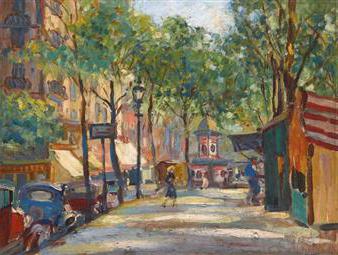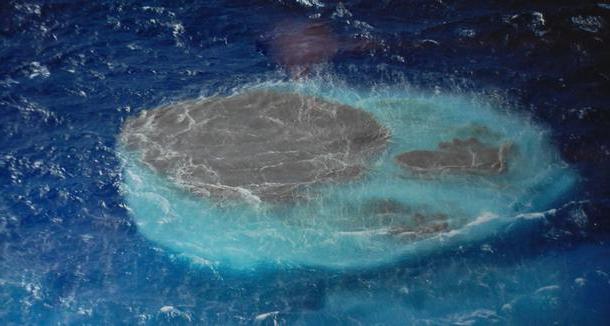Alexander Mikhailovich Gerasimov - brightrepresentative of socialist realism in painting. He became famous for portraits depicting party leaders. But there are in his work and very lyrical works, landscapes, still lifes, images of Russian life. Thanks to them, the artist Gerasimov is known today. “After the Rain” (description of the picture, history of creation, means of artistic expression) - this is the topic of this article.

Gerasimov A.М .: biographical information
Gerasimov A.M.Born in the family of a merchant from the city of Kozlov (present-day Michurinsk) of the Tambov Region on August 12, 1881. In this town, he spent his childhood and youth, here he loved to come and when he became a famous artist.
From 1903 to 1915 he studied in MoscowArt School, immediately after which was mobilized to the front, was the First World War. From 1918 to 1925, the artist lived and worked in his native city, and then returned to Moscow, joined the Association of Artists and after a few years became its president.
Gerasimov A.M. survived periods of ups and downs, was loved by the artist Stalin, received a large number of professional awards and titles. And in times of Khrushchev fell into disgrace.
The artist died in 1963, 3 weeks before his 82 birthday.
The creative way of the artist
Gerasimov studied with the greatest painters of the endXIX - early XX centuries - K.A. Korovin, A.E. Arkhipova, N.A. Kasatkina. At the beginning of his creative career, he painted mostly pictures of national life, portrayed Russian nature with its modest and touching beauty. During this period, were created: "Rye mowing" (1911), "Heat" (1912), "A bouquet of flowers. The Window ”(1914).

In Soviet times, the artist turned to the genreportrait. Talent of Gerasimov showed up surprisingly accurately grasping the characteristic features, achieving great portrait similarity. Gradually, among the heroes of his canvases, high-ranking people, party leaders and leaders began to dominate: Lenin, Stalin, Voroshilov and others. His paintings are distinguished by a solemn mood and are not without some poster pathos.

By the mid 30s of the XX century, the artist becamethe largest representative of socialist realism in painting. In 1935 he went to his hometown to take a break from work and spend time with his family. It was in Kozlov that A.M. Gerasimov "After the Rain" - a picture that brought him the glory of a beautiful landscape painter.
In the years of Stalin’s rule, Gerasimov held responsible leadership positions. He headed the Moscow branch of the Union of Artists, the Association of Soviet Artists, the USSR Academy of Arts.
The story of the painting "After the Rain" by Gerasimov
On the history of the painting told in hertime sister artist. The family rested on the terrace of their home when suddenly it began to rain heavily. But Alexander Mikhailovich did not hide from him, as the rest of the household did. He was shocked by how the water droplets accumulated on the foliage, on the floor, on the table, shimmer with different colors, how fresh and transparent the air became, how, falling on the ground like rain, the sky began to lighten and clear. He ordered to bring him a palette and in just three hours he created a stunningly expressive landscape. The artist Gerasimov called this picture “After the Rain”.
However, the landscape, written so quickly andrapidly, was not accidental in the work of the artist. During his studies at the school, he liked to depict wet objects: roads, plants, roofs of houses. He managed to convey the glare of light, bright, rain-washed paint. Perhaps, for many years, A.M. Gerasimov. "After the rain" was the result of creative searches in this direction. There would be no such prehistory, we would not see the described canvas.
A.M. Gerasimov "After the rain": description of the painting
The plot of the picture is surprisingly simple and concise.The corner of the wooden terrace, a bouquet of flowers on a round dining table and lush green foliage that makes up the background. From the shine of the wooden surfaces, the viewer realizes that heavy rain has recently ended. But moisture does not create a feeling of dampness and neuyuta. On the contrary, it seems that the downpour has muffled the summer heat and filled the space with freshness.
It is felt that the picture was created in one breath.There is no tension and heaviness in it. She absorbed the mood of the artist: light, peaceful. Green trees and flowers in the bouquet are written slightly casually. But the viewer easily forgives this artist, realizing that he was in a hurry to catch this beautiful moment of harmony with nature.
Expressive means
Этот пейзаж (А.М.Gerasimov “After the Rain”), the description of the painting, the expressive means used by the artist, give art historians a reason to talk about the author’s high painting technique. Despite the fact that the picture looks simple and even careless, it manifested the talent of the master. Rainwater made the paint more saturated. Wooden surfaces not only shine, but also reflect the color of greenery, flowers and the sun, cast in silver and gold.
Attracts attention and overturned glass on the table.This seemingly insignificant detail clarifies a lot, makes the plot easy to read. It becomes clear that the rain began unexpectedly and rapidly, took people by surprise, made them rush to collect dishes from the table. Only one glass and a bouquet of garden flowers were forgotten.

A.M. himself considered one of his best works.Gerasimov - "After the rain." The description of the painting presented in this article shows that this work is one of the most significant not only in the work of the artist, but in all Soviet painting.












